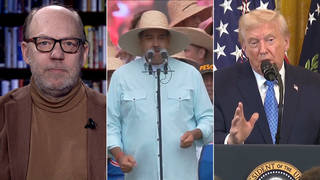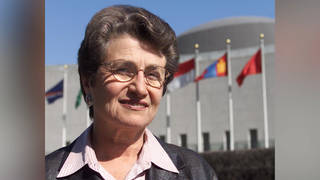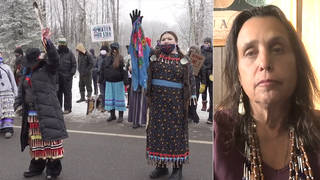
At the U.N. Water Development Conference, U.S. Secretary of the Interior Deb Haaland delivered the U.S. statement and called for Indigenous governance of shared waters, underscoring the importance of Indigenous-led conservation in addressing the climate and drought crises. This comes after the U.S. Supreme Court heard arguments last Monday on whether to allow the Navajo Nation to argue the federal government must address the Native American tribe’s water rights. For more, we are joined in Fort Defiance, Arizona, by Crystal Tulley-Cordova, principal hydrologist for the Navajo Nation Department of Water Resources, water management branch, covering 27,000 square miles of reservation land that straddles New Mexico, Arizona and Utah, much of which borders the Colorado River. She talks about what must be done to address the ongoing lack of access to water there now as the west battles a historic drought.
Transcript
AMY GOODMAN: We’re going to stay in Arizona now. This is Democracy Now!, as we continue from one river, talking about the Nile, to the Colorado River. At the U.N. Water Development Conference, it was U.S. Secretary of the Interior Deb Haaland who delivered the U.S. statement at the U.N. water conference. She also spoke about Indigenous governance of shared waters and the importance of Indigenous-led conservation in addressing the climate and drought crises.
This comes after the U.S. Supreme Court heard oral arguments last Monday on whether to allow the Navajo Nation to pursue a claim that the federal government has a duty to address the Native American tribe’s water rights. Here’s now the environmental news site Grist reported on last week’s Supreme Court hearing, where the justices seem nearly divided: quote, “If the Navajo win, they will have a narrow but workable path to secure a significant water settlement on the Colorado River, but if they lose, their litigation over the river will come to an end, forcing them to look elsewhere for a solution to decades of water access problems.”
For more, we’re joined in Fort Defiance, Arizona, by Crystal Tulley-Cordova, principal hydrologist for the Navajo Nation Department of Water Resources, water management branch, covering 27,000 square miles of reservation land that straddles New Mexico, Arizona and Utah, much of which borders the Colorado River.
Welcome to Democracy Now! Talk about your experience growing up without running water as part of the Navajo Nation, who lives in the Colorado River Basin, and the ongoing lack of access to water there now as the west battles a historic drought.
CRYSTAL TULLEY-CORDOVA: Thank you, Amy.
The opportunity to be able to be in the position that I am now in is to be able to secure a sustainable water future for Navajo residents within the Navajo Nation. And it’s important to consider what the challenges are associated with, you know, the drought that we’ve been experiencing, the impact on water supply. Within the Navajo Nation, we are securing our water future by securing our water rights and protecting our water rights, resolving — trying to resolve some of our water rights that we have that are unresolved, while at the same time we also have projects that we are diversifying our water portfolio, with projects like the Navajo-Gallup Water Supply, that will bring San Juan River water, a tributary to the Colorado River, to be able to service 43 Navajo communities. Currently, we have the Cutter Lateral, a portion of that big water project, that is servicing eight Navajo communities currently.
And, you know, the listeners might be curious: Why is there a need to be able to secure the water future? As described earlier by the people that were a part of the show, you know, groundwater challenges are definitely impact of our availability to access the water. And so, in the Navajo Nation, we have water quality challenges, such as brackish water. So, if people don’t know what brackish water is, it’s salty water. In addition to that, we have legacy mining issues. And added on top of all of that are climate change impacts to waters. And so, shallow aquifers, that we call alluvial aquifers, that are very dependent on precipitation recharge, but in a time of prolonged drought, definitely have their challenges with water availability.
AMY GOODMAN: Well, let me ask you, Crystal Tulley-Cordova, about water rights and if you can talk about what’s at stake in this Supreme Court case.
CRYSTAL TULLEY-CORDOVA: So, I am hopeful for the Supreme Court case. At this time, you know, we really don’t have an understanding what the outcome might be. And we won’t have an outcome of what that might be until June. But in the Navajo Nation, what we continue to do is to work on water projects, regional water supply systems that interconnect smaller public water systems to be able to secure our water future.
AMY GOODMAN: Can you talk about the water infrastructure, and particularly the Biden administration and its stance on Navajo land?
CRYSTAL TULLEY-CORDOVA: Yeah. So, there has been funding that has been available under the American Rescue Plan Act, the Infrastructure Investment and Jobs Act. The Navajo Nation, of its own funding of ARPA, the American Rescue Plan Act funding, that it received, invested $215 million for water and wastewater projects. And then, even at a community level, the community representatives had another opportunity to be able to invest in water and wastewater infrastructure projects with the funding that they’ve received, as well.
With regards to the Infrastructure Investment and Jobs Act, the Indian Health Service, which also helps by connecting homes to the public water system, received $3.5 billion under the — what is also known as the bipartisan infrastructure law. And we are hopeful that this funding — you know, that we’re working every day to be able to close the clean water access gap within the Navajo Nation. And there are a large number of projects that need to be done, regional water systems that provide that water supply, that allows the opportunity for connection of homes to clean, reliable drinking water. At the same time, it’s also important to understand, you know, what the U.N. had in its sustainable water report: sanitation. You know, water in is water out. And it equally important is, because both of those contribute to a successful water system. So we’re working on both accesses for water, both sanitation and also access to clean water.
AMY GOODMAN: Crystal Tulley-Cordova, I want to thank you so much for being with us, principal hydrologist for the Navajo Nation Department of Water Resources, water management branch.
Next up, we remember the human rights leader, lawyer, Randall Robinson, founder of TransAfrica. Stay with us.












Media Options